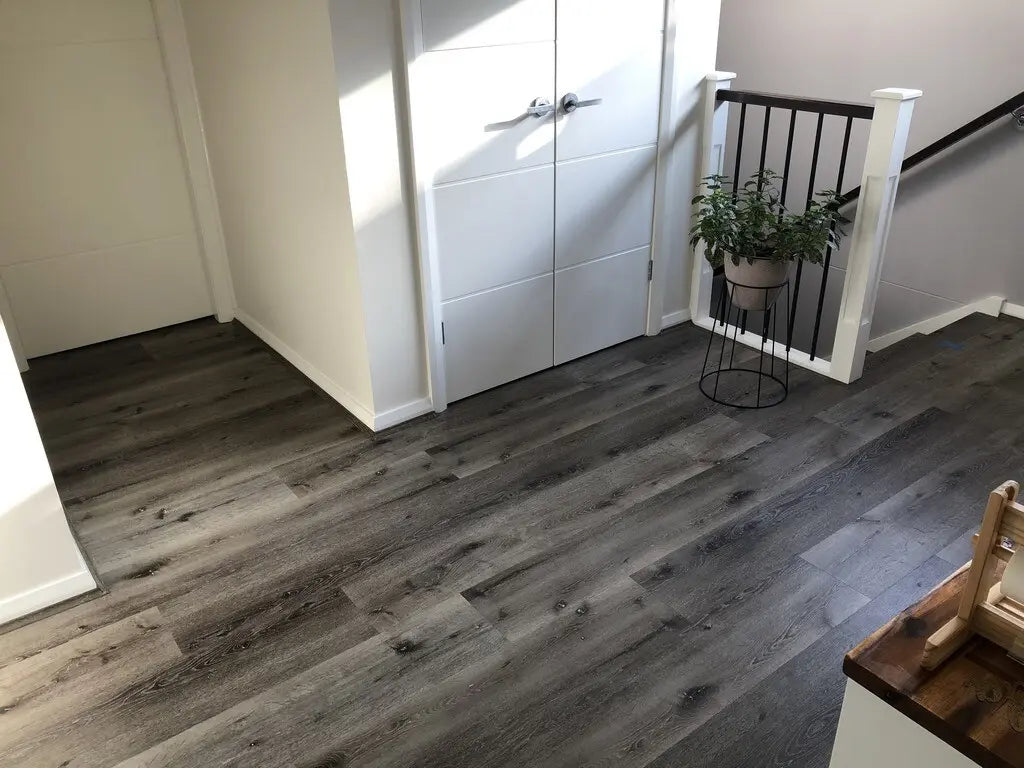What are the Differences Between Hybrid and Laminate Flooring, and Which One Should You Choose?

Understanding Hybrid Flooring
Definition and Composition
Hybrid flooring is the innovative fusion of laminate and vinyl technology, creating a robust flooring option that excels in both appearance and performance. It consists of multiple layers that include a UV-coated top layer for protection, a luxury vinyl print layer that offers the authentic look of natural materials, a rigid core that could be made from a composite of stone plastic composite (SPC) or wood plastic composite (WPC), and a backing layer that enhances its structural integrity and moisture resistance. If you'd like a free measure and quote don't hesitate to contact us.
Key Features
- Durability: Known for its toughness, hybrid flooring is resistant to scratches, dents, and stains, making it ideal for households with pets or children. Its durable surface withstands daily wear and tear, preserving its look over time.
- Water Resistance: Hybrid flooring stands out for its excellent water resistance, making it an ideal choice for areas prone to moisture like kitchens, bathrooms, and basements. Unlike other flooring types, it won't swell or warp when exposed to spills or humidity.
- Comfort: The composition of hybrid flooring provides a warmer and more comfortable underfoot experience compared to traditional hard surfaces. It also offers better acoustic properties, reducing sound transmission and creating a quieter home environment.

Understanding Laminate Flooring
Definition and Composition
Laminate flooring, a mainstay in the flooring market, consists of four main components: a back layer that stabilizes the floorboard, a core layer typically made from high-density fiberboard that adds strength and moisture resistance, a decorative layer with a high-resolution photograph of the floor’s intended appearance, and a clear protective layer that guards against wear and tear.
Key Features
- Cost-Effectiveness: Laminate offers exceptional value, providing the luxurious look of hardwood or stone at a fraction of the cost. This makes it a particularly appealing option for large-scale installations or budget-conscious renovators.
- Aesthetic Variety: The high-resolution imaging technology used in laminate flooring allows for a wide variety of designs and colors, making it easy to match any interior design theme. Whether you are looking for the rustic charm of weathered wood or the sleek appeal of polished stone, laminate can offer a convincing alternative.
- Maintenance: Laminate floors are renowned for their ease of maintenance. Resistant to stains and easy to clean, they require only regular sweeping and occasional damp mopping to stay in pristine condition, avoiding the need for specialized cleaners or treatments.

Comparing Hybrid and Laminate Flooring
1. Moisture Resistance Hybrid flooring's superior resistance to moisture is one of its most significant advantages over laminate. While laminate can withstand some moisture, prolonged exposure can cause warping or bubbling. In contrast, hybrid flooring is designed to withstand high humidity and direct contact with water, making it an ideal choice for all areas of the home, including traditionally wet areas.
2. Durability and Wear Both flooring options are highly durable, but hybrid flooring generally offers enhanced performance in extreme conditions. The composite core in hybrid flooring allows it to resist fluctuations in temperature and humidity better than laminate, which is primarily made of wood byproducts. This makes hybrid floors particularly suitable for areas like sunrooms or homes in climates with significant seasonal changes.
3. Installation Installation is straightforward for both types of flooring, with both options typically offering a click-lock system that allows for easy DIY installation. However, laminate flooring may require a moisture barrier and more careful leveling of the subfloor to prevent moisture damage and ensure a smooth finish.
4. Comfort and Sound Hybrid flooring is generally quieter and more comfortable underfoot than laminate due to its thicker and more resilient composition. This can be a significant advantage in multi-story homes or condominiums where noise transmission can be an issue.
5. Environmental Impact Both laminate and hybrid flooring can be produced with sustainable practices, but the specific environmental impact depends on the manufacturer. Laminate's wood content typically comes from sustainably managed forests, while hybrid floors often incorporate recycled materials in their core layers.

The Choice is Yours!
Deciding between hybrid and laminate flooring is not just about picking a product; it's about selecting the foundation that will support your daily life and enhance the comfort and beauty of your home. As you weigh your options, consider not only the functional aspects of each type of flooring but also how they align with your long-term satisfaction and your home’s overall aesthetic.
For areas of the home that are prone to moisture and humidity, such as kitchens, bathrooms, and basements, hybrid flooring is the superior choice. Its excellent water resistance ensures that it will withstand the rigors of everyday spills and environmental humidity without warping or swelling. This feature alone makes hybrid flooring an invaluable investment for homes in humid climates or families who want peace of mind in their flooring’s durability against moisture.
On the other hand, laminate flooring may be the ideal solution for those who need an economically savvy option without sacrificing the visual appeal of their floors. Laminate offers a breadth of style choices and the convincing look of real wood or stone at a fraction of the cost, making it especially suitable for large areas or rental properties. Additionally, its ease of maintenance—requiring only basic cleaning to keep it looking new—appeals to anyone looking for a low-maintenance flooring option.
SHARE:















